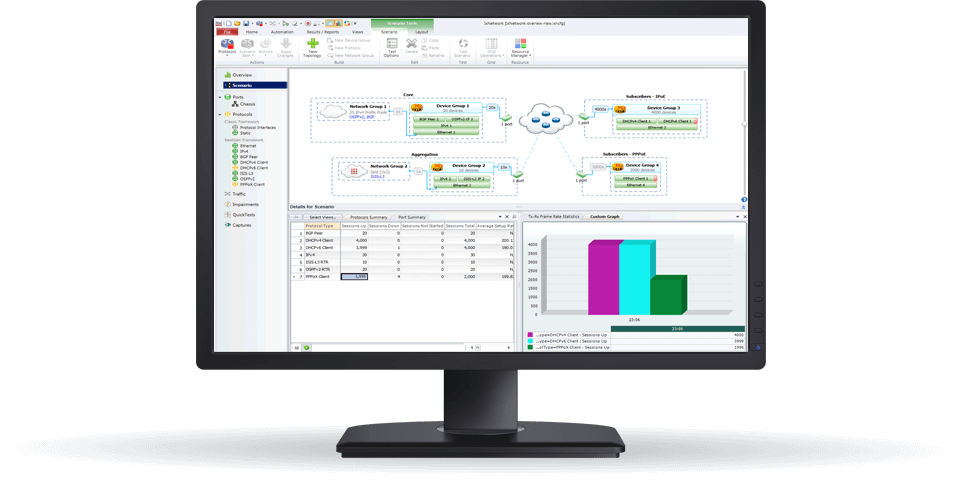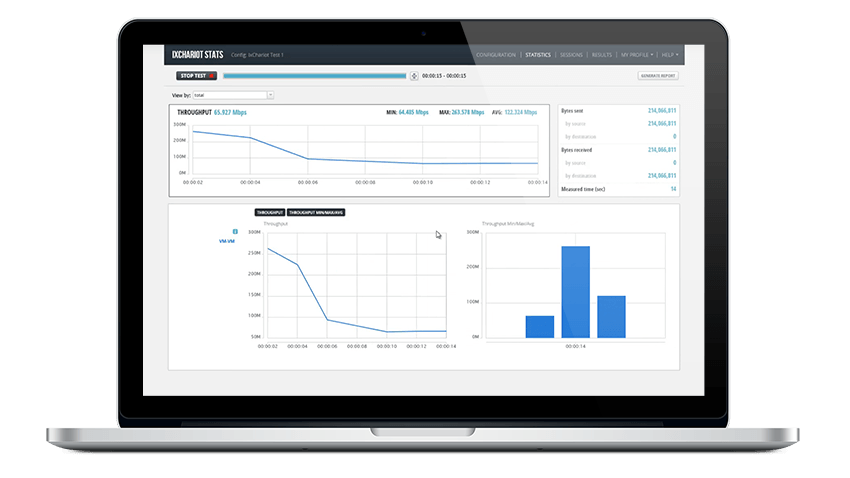O que você está procurando?
Software-Defined Area Networks
Ensure SD-WAN network performance

Balance Low Cost And High Performance
Current wide-area network (WAN) services like multi-protocol label switching (MPLS) and metro Ethernet are expensive and difficult to configure and change. Software-defined WAN (SD-WAN) allows connectivity over the public Internet instead of dedicated links and load balances across multiple MPLS, LTE, or broadband services. Validation is key to ensure new SDN-WAN services meet expectations of cost savings in network operation, faster deployment, efficient load balancing, and increased performance.

Breakingpoint Solves Your Real-world Test Challenges
IxLoad, our application-layer test solution, delivers comprehensive performance validation for user QoE over SDN-WAN services. To create realistic test scenarios, it emulates enterprise applications at scale behind the branch offices or provider SDN-WAN networks. Emulations include protocols for web, video, voice, storage, VPN, wireless, infrastructure, and encapsulation/security applications. With physical or virtual test ports, the modular system design allows distributed deployment that scales with your infrastructure.

The routing capability in the SD-WAN gateway allows SD-WAN to operate in overlay mode. There can be a router on the edge, and the SD-WAN appliance is on the LAN side of that router. Or in some cases, this can be an integrated device with routing intelligence. The WAN gateway needs to incorporate routing intelligence in the overlay network for site-to-site communication to happen over MPLS tunnels. IxNetwork, our flagship product for testing Layer 2/3 infrastructure, emulates protocols and generates traffic at high scale to validate the routing capability of SD-WAN networks.

Network Emulator II, our network impairment test solution, offers a rich feature-set for testing with repeatable and predictable impairments in a controlled lab environment. It enables users to inject realistic network condition, including packet delay, drop, duplication, reorder, and modification, between SD-WAN gateways and provider networks. In combination with IxLoad and IxNetwork, this proactive real-world testing allows customers to find problems in the lab and not during deployment.

Hawkeye, our proactive monitoring platform, ensures you are the first to know what is happening in your network. Hawkeye leverages synthetic traffic monitoring to perform node-to-node and real service testing to determine the end-user experience. It gives you real-time insight, so you can ensure your users' quality of experience. This type of testing is critical in hybrid networks where the SD-WAN solution needs to dynamically steer application traffic over MPLS or Internet links. By knowing end-user experience, you can better meet commitments for throughput, packet loss, jitter, delay, MOS, OTT video, and other SLAs.


Latency Testing Is Critical To Hybrid Wan
In a hybrid network infrastructure, an SD-WAN solution needs to dynamically steer application traffic over MPLS or Internet links—on a per‐packet basis, to ensure enterprise-grade performance and availability. Measuring the latency of this WAN traffic is critical to ensuring high performance. But accurate latency measurement needs an accurate and synchronized clock.
To solve this problem, use our Metronome Timing System to time-synchronize the source port of IxNetwork and the receiving port of IxNetwork. Metronome relies on GPS time input to enable two geographically separated Metronome devices to provide the same time input to our hardware. IxNetwork and the Metronome Timing System is the perfect combination for SD-WAN validation engineers.
Manage SD-WAN Routing Complexities
- OSPF or BGP session establishment over the WAN
- Real-time route learning from the network through OSPF or BGP
- Advertise routes over the WAN for any changes in the LAN side
- Selective route filtering

Related Products
Featured Resources
Connect with a Security Specialist to learn more about how our Security Fabric can transform your security infrastructure.







